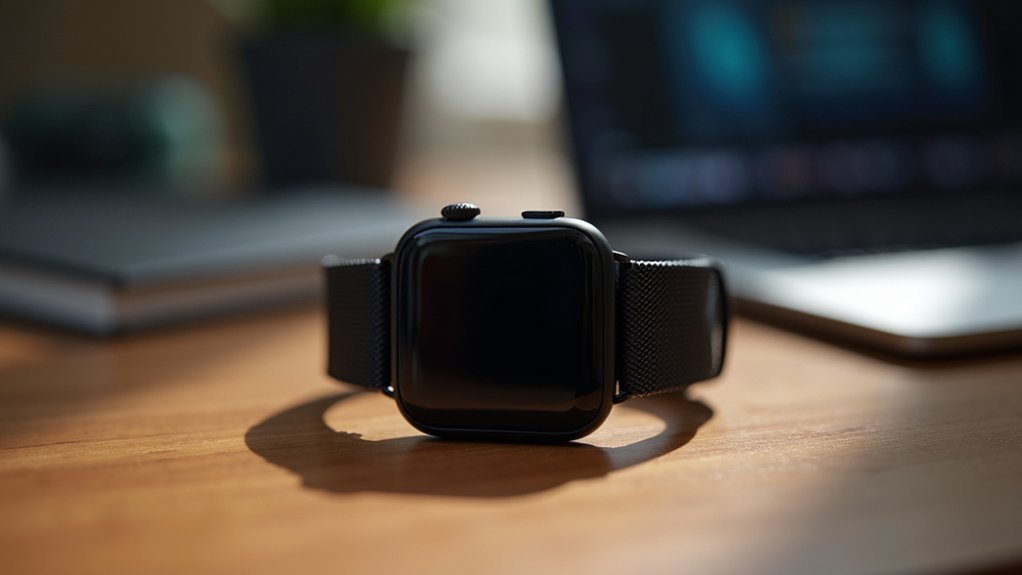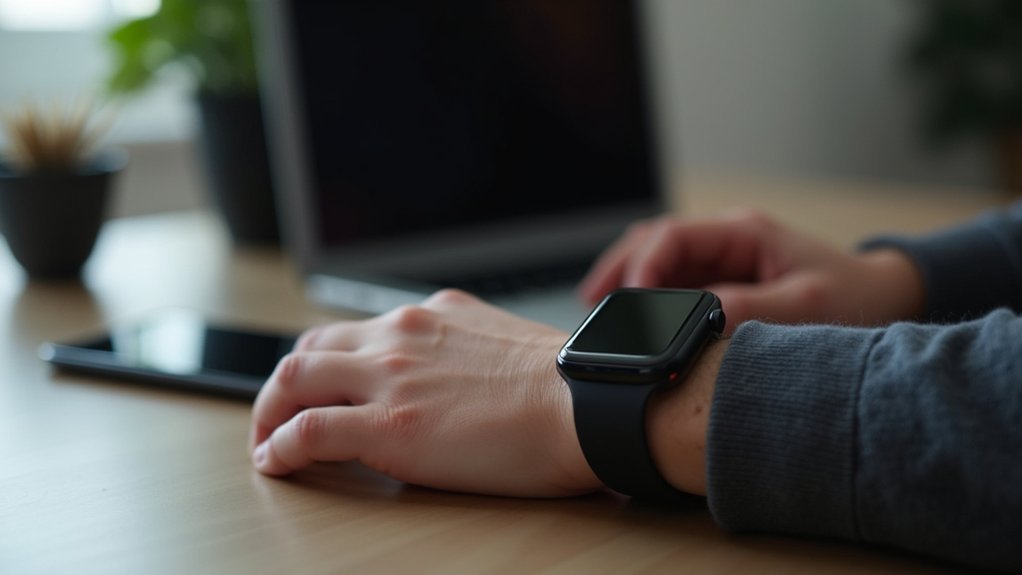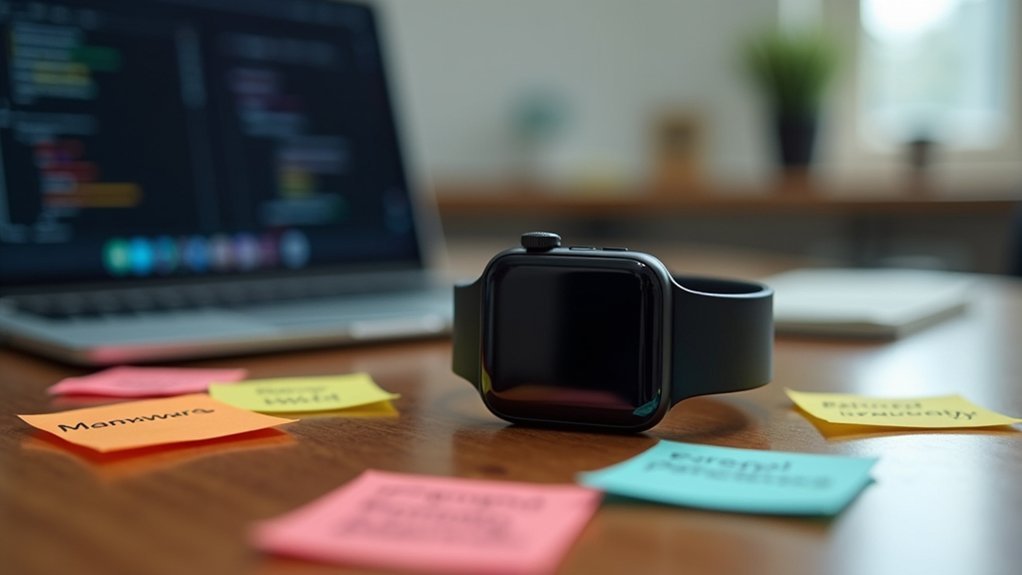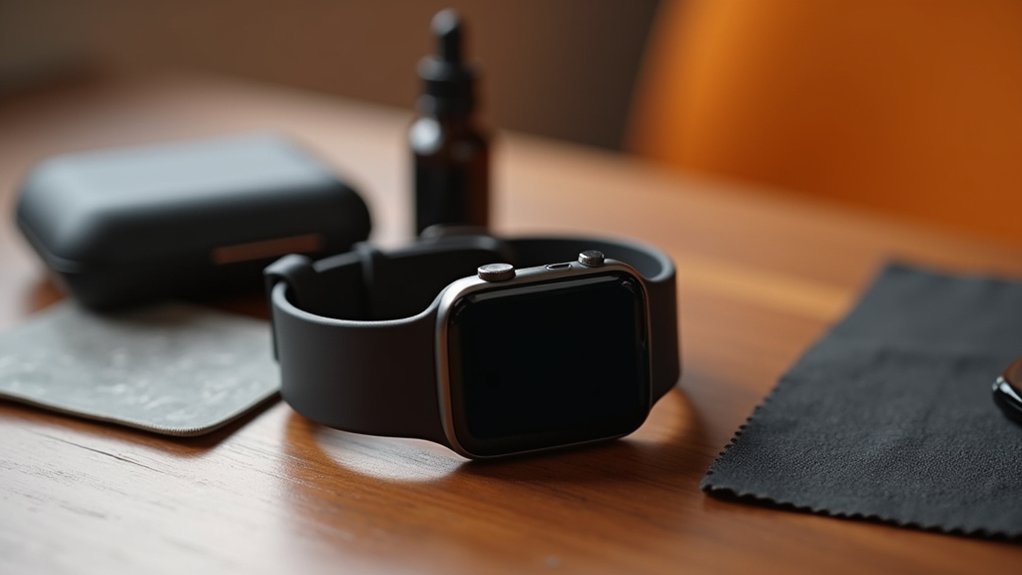Secure your smartwatch by enabling strong PIN or pattern authentication and configuring two-factor authentication for enhanced protection against unauthorized access. You’ll need to manage app permissions carefully, granting access only when necessary for functionality. Keep your device updated with automatic security patches to guard against memory corruption flaws and Bluetooth vulnerabilities. Monitor network activity for unusual data transmissions and review location services regularly. The following thorough strategies will help you maximize your wearable device’s security defenses.
Understanding Common Vulnerabilities in Modern Smartwatch Operating Systems

As smartwatches become increasingly integrated into our daily lives, their operating systems face a growing array of security vulnerabilities that can compromise your personal data and device functionality.
Memory corruption flaws in core media libraries like AppleJPEG and CoreAudio can trigger crashes or enable code execution when processing malicious files.
Bluetooth stack vulnerabilities allow unauthorized access through weak state management and insufficient cryptographic protections, making you susceptible to man-in-the-middle attacks.
Remote code execution bugs in Android-based smartwatch OSes can grant attackers complete device control without your interaction.
Authentication weaknesses plague most devices, lacking multi-factor authentication and proper account lockout mechanisms.
Additionally, inadequate data encryption and privacy controls expose your communications and stored information to potential interception and unauthorized tracking. Security vulnerabilities are classified into categories including remote code execution, elevation of privilege, information disclosure, and denial of service to help users understand the severity and impact of potential threats.
Implementing Strong Authentication and Password Protection Measures
You’ll need to establish multiple layers of security to protect your smartwatch from unauthorized access.
Start by enabling passcode lock protection through PIN or pattern authentication.
Then add two-factor authentication using your connected phone or biometric sensors when available.
Create strong password policies that include regular authentication requirements and automatic lockout mechanisms after failed attempts. Consider implementing passkey authentication which eliminates the need for usernames and allows users to authenticate using device screen lock for enhanced security.
Enable Passcode Lock Protection
A locked door protects your home, and a passcode serves the same function for your smartwatch. You’ll enhance privacy and data security by setting up a 4-digit PIN on compatible devices like Garmin and Samsung smartwatches.
Access your device settings to configure this protection, which requires passcode entry after extended inactivity or when you remove the watch from your wrist. Samsung Wallet specifically requires a security lock to be enabled before you can use payment features on your Galaxy Watch.
Don’t worry about losing functionality—active activities, assistance alerts, and phone calls remain accessible while locked. Your personal health data stays protected behind this security layer.
Choose a unique PIN that others can’t easily guess, and regularly update your software for the latest security features. This simple step considerably strengthens your smartwatch’s defense against unauthorized access.
Implement Two-Factor Authentication
While passcode protection forms your smartwatch’s first line of defense, two-factor authentication (2FA) creates an additional security barrier that greatly reduces unauthorized access risks. You’ll want to implement methods like Duo Push or WebAuthn, which offer strong protection against man-in-the-middle attacks.
| 2FA Method | Key Benefits |
|---|---|
| Duo Push/WebAuthn | Excellent security against man-in-the-middle attacks |
| Biometric + 2FA | Combines fingerprint/face recognition with verification codes |
| OAuth 2.0 | Supports secure Authorization Code and Device Grant protocols |
Your smartwatch can receive authentication notifications directly, enhancing both convenience and security. Consider combining biometric features with traditional 2FA for maximum protection. Make sure you’ve got fallback methods configured and choose options that match your daily usage patterns for best user experience. According to security research, 2FA blocks nearly all automated bot attacks, making it essential for protecting wearable devices from sophisticated threats.
Create Strong Password Policies
Beyond implementing two-factor authentication, establishing thorough password policies becomes critical for maintaining your smartwatch’s security infrastructure.
Create passwords with at least 12 characters combining uppercase, lowercase, numbers, and special symbols. Avoid personal information like birthdays or pet names, and use unique passwords for each device. Password managers help generate and store strong credentials securely.
Enable your smartwatch’s lock screen with automatic activation after brief inactivity periods. Configure Bluetooth pairing restrictions and proximity-based locking features.
Update passwords every 90 days while preventing reuse of recent credentials. Encrypt all password data during storage and transmission, avoiding auto-save features in browsers.
Never share passwords through unsecured channels, and regularly audit your security settings for suspicious activity. Be cautious of QR codes from untrusted sources that may lead to phishing attacks targeting your device credentials.
Configuring Two-Factor Authentication for Enhanced Device Security
You’ll greatly strengthen your smartwatch’s security by implementing two-factor authentication, which requires both your password and a secondary verification method to access your device.
Setting up 2FA involves choosing from available methods like Duo Push, WebAuthn, or SMS notifications that work seamlessly with your wearable’s operating system.
Once configured, you’ll need to manage your security tokens effectively to guarantee they’re updated and functioning properly across all your connected devices. Apple Watch and other trusted devices can serve as verification sources, displaying security codes when you need to authenticate your identity on new devices.
Understanding 2FA Benefits
Two-factor authentication transforms your smartwatch from a potentially vulnerable device into a fortress of digital security by adding a crucial second layer of protection beyond traditional passwords.
Even if hackers steal your login credentials, they can’t access your device without the second authentication factor. This drastically reduces risks from credential stuffing attacks and phishing scams that plague single-password systems.
You’ll benefit from multiple authentication options including biometrics, SMS codes, authenticator apps, and hardware tokens.
Your smartwatch’s unique advantage lies in device separation during authentication—you can verify logins while keeping your phone secure.
Major regulations like GDPR and PCI DSS now require 2FA for sensitive data access, making it essential for compliance.
This protection maintains user trust while securing financial transactions and personal health information. The overall security posture becomes significantly stronger when 2FA integrates with existing security tools for strict access controls.
Setting Up Authentication
Three essential prerequisites must be in place before you can configure two-factor authentication on your smartwatch. You’ll need a compatible device running Wear OS 3+ or an Apple Watch with iOS companion apps. Your smartphone must have the required security app installed, and your watch needs to remain paired and connected.
Download companion apps exclusively from official stores like Google Play or the Apple App Store. Verify the publisher matches your security provider, such as Duo Security LLC. Install the app on your watch through your phone or directly from the watch app store.
For push notification authentication, you must have a PIN set on your watch or keep your phone unlocked to approve requests directly from your smartwatch.
| Authentication Method | Usage | Requirements |
|---|---|---|
| Duo Push Approval | Approve/deny via watch interface | Connected devices, notifications enabled |
| Verified Push | Enter numeric code on watch | Organization code requirements |
| Passcode Generation | Generate codes for manual entry | Updated companion app version |
| Account Search | Find accounts using on-screen keyboard | Multiple account management |
Managing Security Tokens
After establishing your authentication framework, managing security tokens becomes the cornerstone of your smartwatch’s two-factor authentication system.
You’ll need to configure software-based tokens that generate time-based or event-based codes directly on your device. Store cryptographic keys securely using your smartwatch’s built-in protection mechanisms, following OS best practices for secret management.
Activate tokens through dedicated apps like Duo Wear or Saaspass, which’ll send real-time notifications for authentication requests. You can respond using touch, voice, or button inputs to approve or reject login attempts. This eliminates SMS vulnerabilities while providing stronger device binding security.
Remember to rotate tokens periodically and keep authentication apps updated. These dynamic passcodes change constantly to prevent replay attacks and enhance overall security.
Monitor active sessions for suspicious activity, and verify you’ve got secure backup provisioning configured for token recovery.
Managing Software Updates and Security Patch Installation
While your smartwatch may seem like a simple fitness tracker, it’s actually running a sophisticated operating system that requires regular maintenance to stay secure. Developers constantly release updates that enhance performance and fix critical security flaws, making regular updates vital for protecting your device from hackers.
You should configure your smartwatch for automatic updates whenever possible. This guarantees security patches install promptly without requiring manual intervention. If automatic updates aren’t enabled, you’ll receive notifications when updates become available – don’t ignore them.
Installing security patches protects against known vulnerabilities that cybercriminals actively exploit. Many low-end models lack comprehensive security features, making them particularly vulnerable to cyber-attacks.
Regular updates also maintain your smartwatch’s operating system integrity, keeping all security features functioning properly and your personal data safe from unauthorized access.
Controlling App Permissions and Data Access Settings

Beyond keeping your smartwatch updated with the latest security patches, you need to actively manage which apps can access your personal information and device features.
Navigate to your settings and use the permission manager to control what each app can access. Only grant permissions when they’re truly necessary for the app’s core functionality—this maintains your trust while reducing security risks.
Pay special attention to location services since location data is particularly sensitive. Your smartwatch likely mirrors your smartphone’s data access settings, so review these controls regularly.
Request permission rationales from apps to understand why they need specific access. Consider implementing gradual permissions and conduct regular permission audits to guarantee they align with current app functionality, minimizing potential vulnerabilities. Monitor your app’s denial rates through analytics to identify when users frequently reject certain permission requests, which may indicate a need for better explanations or app refactoring.
Recognizing and Preventing Remote Attack Vectors
How can attackers breach your smartwatch without ever touching it? Remote attack vectors exploit vulnerabilities in your device’s communication protocols and sensor systems.
Malicious apps can infiltrate through weak app store vetting or side-loading, then secretly transmit your data to remote servers. Attackers target Bluetooth pairing weaknesses, using brute-force methods to crack weak PINs and intercept communications.
Your smartwatch’s motion sensors pose particular risks since they lack robust access restrictions. Cybercriminals can analyze this sensor data to infer your activities, including keystroke patterns on nearby devices. Sophisticated attackers use packet capturing tools to intercept and analyze data transmitted between your smartwatch and other connected devices.
Protect yourself by:
- Monitoring network activity for unusual data transmissions indicating potential breaches
- Updating firmware regularly to patch security vulnerabilities before exploitation
- Restricting app permissions and avoiding installations from untrusted sources or side-loading channels
Protecting Personal and Workplace Data From Unauthorized Access

Once attackers bypass your smartwatch’s perimeter defenses, they’ll target the personal and workplace data stored within.
You must implement strong authentication using fingerprints or facial recognition beyond basic passwords. Grant apps only minimal permissions necessary for functionality, and regularly review what data they’re accessing.
Enable encryption for all sensitive data transfers between your smartwatch and other devices.
Configure your device to lock automatically when removed from your wrist or when it moves away from paired devices. Use secure Wi-Fi networks exclusively, and disable Bluetooth in unsecured areas to prevent unauthorized connections.
Download apps only from verified stores to avoid malware infiltration. Implement two-factor authentication for critical accounts, and establish account lockout policies after failed login attempts to protect both personal and workplace information. Keep your smartwatch firmware updated with security patches to address newly discovered vulnerabilities.
Evaluating Security Features Across Different Smartwatch Platforms
When selecting a smartwatch, you’ll encounter vastly different security architectures that directly impact your data protection. Each platform offers unique strengths and vulnerabilities that you should consider before making your choice.
watchOS leads with stringent app sandboxing and end-to-end encryption, leveraging its closed iPhone ecosystem to minimize attack surfaces.
Wear OS provides broader compatibility but increases risk through cross-platform integration, though it compensates with advanced ECDH encryption and Google Play Protect scanning.
Tizen focuses on Samsung’s controlled environment with application certification and encrypted storage. The platform also offers Urdu language support which enhances accessibility for users in diverse markets.
Key security differentiators include:
Critical factors that separate secure smartwatches from vulnerable ones when evaluating your personal data protection needs.
- Update frequency – Apple delivers consistent patches while others vary considerably
- Ecosystem control – Closed systems offer better security than open platforms
- Authentication methods – Biometric integration versus basic password protection
Your platform choice directly influences your vulnerability exposure.
Frequently Asked Questions
Can My Smartwatch Be Hacked While I’m Sleeping or Exercising?
Yes, your smartwatch can be hacked while sleeping or exercising. It stays connected and discoverable, making Bluetooth vulnerable to attacks. During exercise, it transmits more data, increasing interception risks considerably.
Do Fitness Tracking Apps Share My Health Data With Third Parties?
Yes, about 80% of fitness apps share your health data with third parties, including location, biometric data, and personal information. They’ll often sell this data to advertisers unless you’re using HIPAA-protected apps.
Should I Wear My Smartwatch During Confidential Business Meetings?
You shouldn’t wear your smartwatch during confidential meetings. It can expose sensitive data, lacks robust security features, and poses physical security risks that could compromise business information through unauthorized access.
How Often Do Smartwatch Manufacturers Release Critical Security Patches?
You’ll find major manufacturers like Samsung release monthly patches for high-end models, then quarterly. However, most brands don’t publish standardized schedules, and smaller manufacturers often provide infrequent updates.
Can Attackers Access My Smartphone Through My Connected Smartwatch?
While attackers can’t directly bridge from your smartwatch to your smartphone, they can intercept synced data, exploit shared accounts, or potentially transmit malware through compromised connections between your devices.
In Summary
You’ve learned the essential steps to fortify your smartwatch against security threats. By implementing strong authentication, enabling two-factor verification, maintaining current software updates, and carefully managing app permissions, you’re greatly reducing your vulnerability to attacks. Don’t overlook the importance of understanding your device’s specific security features and regularly reviewing your data access settings. Your smartwatch can be both convenient and secure with these protective measures in place.





Leave a Reply